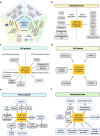The Hippo signalling pathway and its implications in human health and diseases
- PMID: 36347846
- PMCID: PMC9643504
- DOI: 10.1038/s41392-022-01191-9
The Hippo signalling pathway and its implications in human health and diseases
Erratum in
-
Correction: The Hippo signalling pathway and its implications in human health and diseases.Signal Transduct Target Ther. 2024 Jan 4;9(1):5. doi: 10.1038/s41392-023-01682-3. Signal Transduct Target Ther. 2024. PMID: 38172156 Free PMC article. No abstract available.
Abstract
As an evolutionarily conserved signalling network, the Hippo pathway plays a crucial role in the regulation of numerous biological processes. Thus, substantial efforts have been made to understand the upstream signals that influence the activity of the Hippo pathway, as well as its physiological functions, such as cell proliferation and differentiation, organ growth, embryogenesis, and tissue regeneration/wound healing. However, dysregulation of the Hippo pathway can cause a variety of diseases, including cancer, eye diseases, cardiac diseases, pulmonary diseases, renal diseases, hepatic diseases, and immune dysfunction. Therefore, therapeutic strategies that target dysregulated Hippo components might be promising approaches for the treatment of a wide spectrum of diseases. Here, we review the key components and upstream signals of the Hippo pathway, as well as the critical physiological functions controlled by the Hippo pathway. Additionally, diseases associated with alterations in the Hippo pathway and potential therapies targeting Hippo components will be discussed.
© 2022. The Author(s).
Conflict of interest statement
K.L.G. is a co-founder of and has equity interest in Vivace Therapeutics. Other authors declare that they have no conflict of interest.
Figures





References
Publication types
MeSH terms
Substances
LinkOut - more resources
Full Text Sources
Other Literature Sources
Medical
Research Materials

